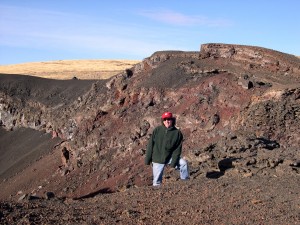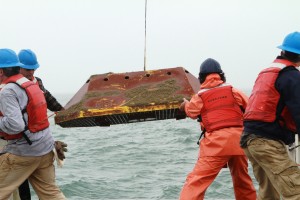Oceanographer Kincaid ’83 Publishes Study of Volcanism in Nature

Plate subduction, magmatism, and mantle plumes are the focus of a recent study by Christopher Kincaid ’83, professor of oceanography at the University of Rhode Island. A highly contested topic, the three proposed causes of volcanism in the northwestern United States led Kincaid and his team aboard the RV Endeavor to publish an article in the scientific journal Nature.
“I always tell people that I got on this track to being an oceanographer because of my time at Wes,” Kincaid said. “I can trace it back to taking small geology classes alongside master’s level grad students. It made a huge impression on me how devoted they were to the pursuit of science. I always tell people this is something that sets Wes apart from other small NESCAC-y type places.”
Kincaid and his team, including earth and environmental sciences major Justin Rogers ’05—then working on his master’s at URI with Kincaid—set out to determine the cause of volcanism in the area through laboratory models and fieldwork. In the article, Kincaid explained that the Yellowstone mantle plume lies at the heart of the volcanic patterns.
“Here we use experiments with a laboratory model to show that the patterns of volcanism in the northwestern United States can be explained by a plume upwelling through mantle that circulates in the wedge beneath a subduction zone,” he wrote in the article.

Kincaid and his team tested the plume model in the northwestern region by using a “first of a kind fluid dynamics laboratory” device that they created.
“Results show that when the plate tectonic motions in this area are included, plumes actually get pulled apart and surface in patterns that closely match observations in this region,” Kincaid said. “This will likely set off a flurry of counter-arguments.”
Many scientists reject the idea of a mantle plume, especially in the Yellowstone region. According to Kincaid, critics of the mantle plume cite “odd offsets between” the Columbia River Flood Basalts and Yellowstone hotspot to argue that the patterns cannot be attributed to a plume.
“From my days as an undergrad at Wes, to my very first research grant with Wes’s own Professor of Earth and Environmental Science Peter Patton on the hotly debated causes of pollution in the Housatonic River, I have been taught to not shy away from a debate,” Kincaid said. “There is a very heated debate in the earth sciences community about the very existence of a mode of deep earth convection called mantle plumes.”
The results of Kincaid’s experiments go beyond the mantle plume model and suggest a mechanism for reduced greenhouse gases in the earth’s atmosphere, which in turn reveals possible causes for differing developments among planets.
“Our results also seem to point to the existence of one more protective feature[s] of our planet,” Kincaid noted. “In similar fashion to the protective atmosphere, which lets in light but filters harmful rays, we find that certain aspects of plate tectonics on earth actually stall and diffuse much of the massive melt production potential of mantle plumes, dramatically limiting output of greenhouse gases to the atmosphere from earth’s interior through geologic time. Without plate tectonics, Venus does not have this protective mechanism, which could account for some of the difference in evolution of the two planetary atmospheres.”
Read more:
http://www.gso.uri.edu/users/kincaid
http://www.abc.net.au/science/articles/2013/04/08/3730801.htm

